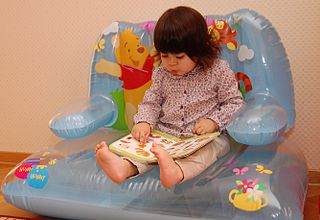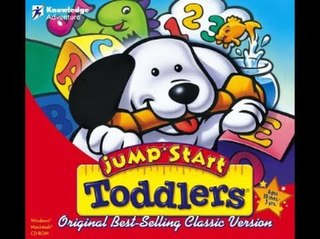
A toy or plaything is an object that is used primarily to provide entertainment. Simple examples include toy blocks, board games, and dolls. Toys are often designed for use by children, although many are designed specifically for adults and pets. Toys can provide utilitarian benefits, including physical exercise, cultural awareness, or academic education. Additionally, utilitarian objects, especially those which are no longer needed for their original purpose, can be used as toys. Examples include children building a fort with empty cereal boxes and tissue paper spools, or a toddler playing with a broken TV remote control. The term "toy" can also be used to refer to utilitarian objects purchased for enjoyment rather than need, or for expensive necessities for which a large fraction of the cost represents its ability to provide enjoyment to the owner, such as luxury cars, high-end motorcycles, gaming computers, and flagship smartphones.

Baby sign language is the use of manual signing allowing infants and toddlers to communicate emotions, desires, and objects prior to spoken language development. With guidance and encouragement, signing develops from a natural stage in infant development known as gesture. These gestures are taught in conjunction with speech to hearing children, and are not the same as a sign language. Some common benefits that have been found through the use of baby sign programs include an increased parent-child bond and communication, decreased frustration, and improved self-esteem for both the parent and child. Researchers have found that baby sign neither benefits nor harms the language development of infants. Promotional products and ease of information access have increased the attention that baby sign receives, making it pertinent that caregivers become educated before making the decision to use baby sign.

Baby Einstein, stylized as baby einstein, is an American franchise and line of multimedia products, including home video programs, CDs, books, flash cards, toys, and baby gear that specialize in interactive activities for infants and toddlers under three years old, created by Julie Aigner-Clark. The franchise is produced by The Baby Einstein Company.

The National Toy Hall of Fame is a U.S. hall of fame that recognizes the contributions of toys and games that have sustained their popularity for many years. Criteria for induction include: icon status ; longevity ; discovery ; and innovation. Established in 1998 under the direction of Ed Sobey, it was originally housed at A. C. Gilbert's Discovery Village in Salem, Oregon, United States, but was moved to the Strong National Museum of Play in Rochester, New York, in 2002 after it outgrew its original home.

Vocabulary development is a process by which people acquire words. Babbling shifts towards meaningful speech as infants grow and produce their first words around the age of one year. In early word learning, infants build their vocabulary slowly. By the age of 18 months, infants can typically produce about 50 words and begin to make word combinations.
Language development in humans is a process which starts early in life. Infants start without knowing a language, yet by 10 months, babies can distinguish speech sounds and engage in babbling. Some research has shown that the earliest learning begins in utero when the fetus starts to recognize the sounds and speech patterns of its mother's voice and differentiate them from other sounds after birth.
Baby videos are educational tool which can be used for teaching babies as young as six months by introducing the alphabet, different sights, shapes and colors, numbers and counting. Baby videos can be used for helping babies learn important educational skills, comprehension, introduction to the environment, as well as music. Some parents use baby videos to help develop their children's motor skills and open their young minds to the world. Certain preschools, educators and caregivers find baby videos to be a useful tool, but medical professionals have yet to determine whether or not baby videos are beneficial to children or not.

The V.Smile is a sixth-generation educational home video game console manufactured and released by VTech. The system was first released on August 4, 2004. Its titles are available on ROM cartridges called "Smartridges", a pun on the system's educational nature. Several variants of the V.Smile console are sold, including handheld versions and models with added functionality such as touch tablet integrated controllers or microphones. The V.Motion is a variant that includes motion-sensitive controllers and has titles designed to take advantage of motion-related "active learning".
Sesame Beginnings is a line of products and a video series, spun off from the children's television series Sesame Street, featuring baby versions of the characters. The line is targeted towards infants and their parents, and products are designed to increase family interactivity.
Child development stages are the theoretical milestones of child development, some of which are asserted in nativist theories. This article discusses the most widely accepted developmental stages in children. There exists a wide variation in terms of what is considered "normal", caused by variations in genetic, cognitive, physical, family, cultural, nutritional, educational, and environmental factors. Many children reach some or most of these milestones at different times from the norm.

Gross motor skills are the abilities usually acquired during childhood as part of a child's motor learning. By the time they reach two years of age, almost all children are able to stand up, walk and run, walk up stairs, etc. These skills are built upon, improved and better controlled throughout early childhood, and continue in refinement throughout most of the individual's years of development into adulthood. These gross movements come from large muscle groups and whole body movement. These skills develop in a head-to-toe order. The children will typically learn head control, trunk stability, and then standing up and walking. It is shown that children exposed to outdoor play time activities will develop better gross motor skills.

Child development involves the biological, psychological and emotional changes that occur in human beings between birth and the conclusion of adolescence. It is—particularly from birth to five years— a foundation for a prosperous and sustainable society.

Educational toys are objects of play, generally designed for children, which are expected to stimulate learning. They are often intended to meet an educational purpose such as helping a child develop a particular skill or teaching a child about a particular subject. They often simplify, miniaturize, or even model activities and objects used by adults.
Play value is the essential value of a toy or game for play. The term is frequently employed in the field of child development and playwork for the assessment of toys, games, equipment and spaces. When they are fun and engaging, playthings and spaces are said to have play value; those that are quickly discarded or are considered uninteresting do not. In short, objects of play must be compelling and encourage the child's involvement in order to have true play value. Play value has been defined as 'how much play can you get out of something'. Classic toys are examples of toys with true play value as they continue to provide new discoveries and adventures in each subsequent session of play.

Play is a range of intrinsically motivated activities done for recreational pleasure and enjoyment. Play is commonly associated with children and juvenile-level activities, but may be engaged in at any life stage, and among other higher-functioning animals as well, most notably mammals and birds.
Anne Fernald is an American psychologist. She serves as the Josephine Knotts Knowles Professor in Human Biology at Stanford University and has been described as "the leading researcher in infant-directed speech".
Emergent literacy is a term that is used to explain a child's knowledge of reading and writing skills before they learn how to read and write words. It signals a belief that, in literate society, young children—even one- and two-year-olds—are in the process of becoming literate. Through the support of parents, caregivers, and educators, a child can successfully progress from emergent to conventional reading.
Social emotional development represents a specific domain of child development. It is a gradual, integrative process through which children acquire the capacity to understand, experience, express, and manage emotions and to develop meaningful relationships with others. As such, social emotional development encompasses a large range of skills and constructs, including, but not limited to: self-awareness, joint attention, play, theory of mind, self-esteem, emotion regulation, friendships, and identity development.

Lovevery is an American company producing play-kit subscription boxes for children.

JumpStart Toddlers is a 1996 educational video game, the fourth within the JumpStart franchise. An enhanced version was released in 2000.











